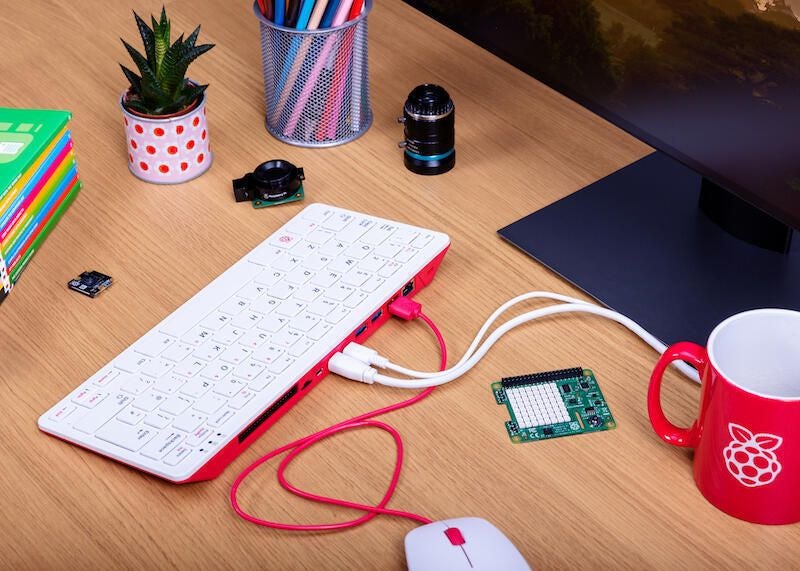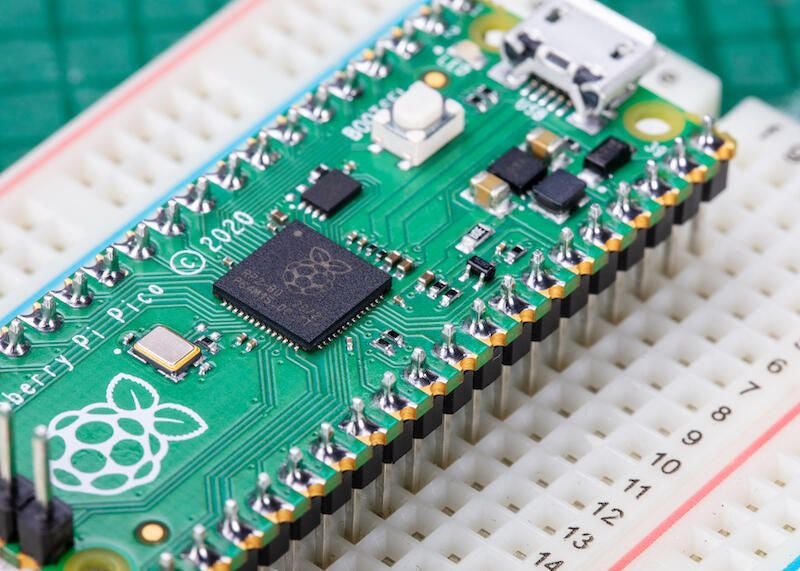For Raspberry Pi, the passage of time over the past year has been marked by the launches of a series of new products (four devices in 2020, to be precise, plus another device in January this year), a feat the British computer maker managed to pull off despite the country being plunged into a series of COVID-19 lockdowns.
Demand for its tiny computers soared due to the overnight switch to home working. On top of that, after the launch of Raspberry Pi’s High Quality Camera in April 2020, the company went on to launch the 8GB Raspberry Pi 4 one month later. This would be followed by the Compute Module 4, the Raspberry Pi 400, and most recently, the $4 Raspberry Pi Pico in January this year.
“We went into the pandemic with this enormous pipeline of stuff to do,” Raspberry Pi creator and co-founder, Eben Upton, tells TechRepublic. “Every single one of those [launches] moves us forward quite a long way.”
When you consider the impact COVID-19 has had on supply chains and production lines across the world, it’s a pretty remarkable accomplishment that the Raspberry Pi team found the energy and resources to deliver five new devices. And while 2021 will see a change in emphasis, Raspberry Pi has big plans for this year, too.

Image: Raspberry Pi
2020: The year of budget computing
Raspberry Pi was one of the first companies to see the impact of the overnight shift to remote working in 2020. That’s because households, which might have found one PC enough for a family in normal times, suddenly needed to meet the needs of multiple family members working and learning from home simultaneously.
As the coronavirus pandemic began to build around the world, one of the more foreboding signs that Upton and his team were in for a difficult year came when they began finding face masks packed in with boxes of components sent by suppliers.
“We were actually getting sent masks by our Chinese suppliers as gifts,” says Upton. “They were like, ‘Hey, you guys are going to have a bit of trouble in the next few weeks, you’ll need these.'”
Download this article as a PDF (free registration required).
For many consumers looking to find a device fast, the benefits of Raspberry Pi’s lineup of sub-$50 devices, some of which pack the power of a basic desktop into their tiny frame, were obvious. Demand rocketed, and in March 2020, sales of Raspberry Pi devices hit 640,000, the second-biggest sales month in the company’s history.
The company went on to sell 7.1 million units over the course of 2020, Upton tells TechRepublic.
One of the most radical new products in the Raspberry Pi family in 2020 – certainly from a design standpoint – was the Pi 400. Released in November, the Pi 400 effectively took the company’s flagship Raspberry Pi 4 and crammed it into a keyboard. Coming at a time when families were still struggling to find ways to keep everyone entertained and educated while stuck at home, it has also found a ready market of households with tight budgets and ever tighter desk space.
Upton says that the timing of the Raspberry Pi 400 was purely coincidental. The company had, after all, been running with the idea of putting a Raspberry Pi inside a keyboard for more than four years, though if anything they wish it had come sooner.

Image: Raspberry Pi
“The pandemic kicked off, and we were all like, ‘God, if only we had Pi 400!'” he says. The team actually thought the pandemic would be over by the time the Raspberry Pi 400 launched in the winter of 2020, a viewpoint about the course of the pandemic that, alas, turned out to be optimistic.
According to Upton, sales of the Raspberry Pi 400 sit at between 300,000 and 400,000 units as of March 2021. He explains that the company struggled a bit with getting production volumes up due to the more complicated design, and the fact it requires some manual assembly.
As he explains, manufacturing the Raspberry Pi is now an almost fully automated process: the devices come through automated assembly in a panel of nine, and you break the panel – that’s it.

“With the Pi 400, it’s lower volume, so things like test automation is less advanced. And you’ve got to then get it into the plastics. It’s got screws inside it; you’ve got to assemble the heat sink onto it; you’ve got to put the whole thing together. That’s still a manual process.”
How Raspberry Pi has helped COVID-19 patients, charities, students and parents
On top of its exhausting hardware release cycle, Raspberry Pi has been involved in a number of charitable and social initiatives over the past year, from providing equipment to help underprivileged schoolchildren learn from home, to shipping its devices halfway across the world to be used in ventilators for COVID-19 patients.
Upton says Raspberry Pi is continuing the rollout of Raspberry Pi devices to support students and parents who are working from home. The Raspberry Pi Foundation announced in February that it had delivered its 5,000th kit through its Learn at Home fundraiser campaign, which has been funded by UK charity the Bloomfield Trust.
SEE: Juggling remote work with kids’ education is a mammoth task. Here’s how employers can help (free PDF) (TechRepublic)
The company has also been selling kits to schools directly, or otherwise offering wholesale pricing to local charitable organizations who then go out and get equipment into the hands of kids and parents. Cobble together a 2GB Raspberry Pi with a mouse, keyboard and basic display, Upton says, and you’ve got something far more capable than the entry-level laptops offered to schoolkids under government-run initiatives in the UK.
“What you unlock with forty quid (£40) is enormous compared to what you could unlock even with the cheapest Chromebook. And cheap Chromebooks are garbage,” he adds.
“People working from home, studying from home… it’s a huge part of the business now.”

Image: Raspberry Pi
Filling a bucket with no bottom
Raspberry Pi’s latest device, the Pico, marks another first for the company, both in the fact it is the first microcontroller-class product in its device range, as well as the first to use Raspberry Pi’s own custom CPU.
The Raspberry Pi Pico has been extremely popular. When TechRepublic spoke to Upton in early March 2021, Raspberry Pi had shipped 200,000 units and had a 700,000-unit backlog. “We’ve now shipped another 100,000, but have taken another 200,000 more orders,” says Upton.
“It’s like filling a bucket with no bottom. At $4, there’s just a suspicion people probably buy them in tens,” he says.
Single-unit sales of the underlying silicon – the RP2040 – will commence later this year, targeting what Upton calls “a fairly aggressive price point.” Though he points out that supply chains are still very tight.
The Pico is no different to Raspberry Pi’s other products in that it’s aimed primarily at education – something you’d be forgiven for forgetting, given the company’s dedicated following of DIY tinkerers.
Download this article as a PDF (free registration required).
What’s exciting about Pico, says Upton, is that it takes Raspberry Pi into brand new territory. Microcontrollers might be a new market for the company, but it’s one that sits adjacent to the traditional Raspberry Pi family.
“Look at Compute Module, Pico and Pi 400. They’re doubling down on three aspects of the Raspberry Pi product. The Pi 400 is the doubling down on Raspberry Pi: the PC. Compute Module 4 is doubling down on Raspberry Pi: the embedded system,” he says. “And then Pico takes us into a whole new world.”

Image: Raspberry Pi
Software will be the focus for Raspberry Pi in 2021
While 2020 may have been a commercial success for the Raspberry Pi, the company wasn’t spared the impact of COVID-19 on its workplace. As with many offices, the coronavirus limited access to the office almost exclusively to engineers who’d be unable to do their work elsewhere.
“We’ve got expensive gear that if you move it, you have to recalibrate it, so it has to stay in the lab,” Upton says.
“We don’t really believe that you can do effective engineering remotely. You could argue that the last year has demonstrated that you can do effective engineering remotely, but I think you can only do it with people who are already [working] together.”
While churning out new products has served Raspberry Pi well in keeping its team busy during 2020’s darkest days, Upton hints that 2021 will be a considerably quieter year for Raspberry Pi hardware, at least.
Raspberry Pi went into the pandemic with a pipeline of hardware to deliver, but now that’s no longer the case: COVID-19 has thoroughly emptied out the hardware pipeline, says Upton.

Image: Raspberry Pi
Does that mean no imminent plans for a Raspberry Pi 5, then? “We’re thinking about it. We’re not quite sure what it’ll look like yet,” he says.
But even without new hardware on the cards, 2021 looks set to offer little respite for the Raspberry Pi team. “We’ve probably started more new things in lockdown than we’ve put into the world, so it’s going to be another busy year for us,” Upton says.
Software seems to be the name of the game in 2021. For starters, Raspberry Pi is aiming to migrate the platform to Debian 11 by the middle of the year. “This will bring updates to lots of bits of the system, including taking many of the Mesa 3D graphics stack optimisations that we’ve sponsored over the last couple of years upstream,” says Upton.
Download this article as a PDF (free registration required).
Upton is also looking forward to seeing the impact of a more up-to-date Chromium on Raspberry Pi, with changes allowing Raspberry Pi to be much closer to the bleeding edge of browser development, “so you really are getting the shiniest Chromium on your Raspberry Pi,” he says.
One of the benefits of working with the shiniest version of Chromium is having the multimedia prowess to do things like, say, video conferencing, which is apt in the current age of remote work, remote education, remote pretty-much-everything.
“We’re on Chromium 88 now, so we’re right up against the bleeding edge,” says Upton. “That’s really important because a lot of the video-conferencing platforms in particular are very aggressive users of cutting-edge browser features, and if we’re saying this is a great platform to work from home on, you need to support conferencing platforms.”
If 2020 was the year for new Raspberry Pi hardware, then 2021 could be the year that software takes the centre stage. With the company now heavily invested in consumer and industrial markets, Upton and his team have their work cut out for them to keep things in-step with the rapidly changing times.
“You’re pushing water uphill, really, with software,” he says. “We’re on a number of treadmills. We’re on a kernel treadmill, we’re on the Debian treadmill, we’re on the Chromium treadmill. All of those consume a lot of effort.
“We’re making really good progress on the multimedia integration at the moment; we have proper Vulkan 1.1 support. Although again, every standard like that is also a treadmill.”
Yet there is also clear excitement around what the rest of the year has in stock for Raspberry Pi Pico and its underlying silicon. Backlogs and supply chain issues aside, there’s something of a sense of déjà vu around the launch of the Pico, which Upton likens to the hubbub and enthusiasm that surrounded the launch of the first Raspberry Pi device nine years ago.
“Right now, it’s 2012 for Pico,” he says. “It’s February, March, April 2012. All of the same excitement is there, and it’s wonderful.”
Download this article as a PDF (free registration required).

Image: Raspberry Pi

